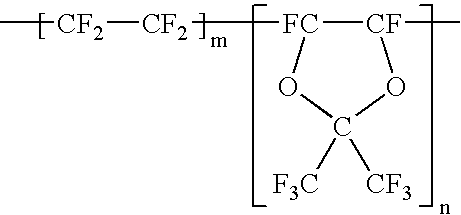Implantable medical devices with fluorinated polymer coatings, and methods of coating thereof
a technology of fluorinated polymer and medical devices, which is applied in the field of implantable medical devices with fluorinated polymer coatings, and methods of coating thereof, can solve the problems of the toxic effect of transition metal ions on the surrounding tissue, and the corrosion of the metallic surface of the stent, etc., and achieves the effect of low friction coefficien
- Summary
- Abstract
- Description
- Claims
- Application Information
AI Technical Summary
Benefits of technology
Problems solved by technology
Method used
Image
Examples
example 1
Coating a Vascular Stent with Amorphous PTFE Polymer
[0036]In a 250 ml glass beaker, 1 g TEFLON® AF 1600 and 19 g FLUORINERT® FC40 are mixed until a homogeneous clear solution is obtained. The solution is filtered using a 0.2 micron glass filter, and then used in coating application. A Nitinol stent from Angiomed (Memoflexx stent 8 mm diameter, 50 mm length) is dipped in the polymer solution and removed from the solution. The solvent is removed by air-drying. A transparent thin polymer coating is visible on the stent surface when viewed microscope.
example 2
Method of Obtaining a Porous Fluoropolymer Coating
[0037]In a 250 ml glass beaker, 1 g TEFLON® AF 1600 and 19 g FLUORINERT® FC40 are mixed until a homogeneous clear solution is obtained. To this solution 5 g sodium chloride is added and the solution / suspension is stirred using a magnetic stirrer. A Nitinol stent from Angiomed (Memoflexx stent 8 mm diameter, 50 mm length) is dipped in the polymer solution. The solvent is removed by air-drying. The stent is then transferred into a beaker containing 1000 ml distilled water, and incubated until salt is leached out completely. The removal of salt creates a porous polymeric coating. The porosity may help to induce tissue in-growth.
PUM
| Property | Measurement | Unit |
|---|---|---|
| thickness | aaaaa | aaaaa |
| thickness | aaaaa | aaaaa |
| thickness | aaaaa | aaaaa |
Abstract
Description
Claims
Application Information
 Login to View More
Login to View More - R&D
- Intellectual Property
- Life Sciences
- Materials
- Tech Scout
- Unparalleled Data Quality
- Higher Quality Content
- 60% Fewer Hallucinations
Browse by: Latest US Patents, China's latest patents, Technical Efficacy Thesaurus, Application Domain, Technology Topic, Popular Technical Reports.
© 2025 PatSnap. All rights reserved.Legal|Privacy policy|Modern Slavery Act Transparency Statement|Sitemap|About US| Contact US: help@patsnap.com

